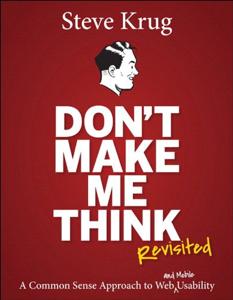
Want to learn the ideas in Don’t Make Me Think, Revisited better than ever? Read the world’s #1 book summary of Don’t Make Me Think, Revisited by Steve Krug here.
Read a brief 1-Page Summary or watch video summaries curated by our expert team. Note: this book guide is not affiliated with or endorsed by the publisher or author, and we always encourage you to purchase and read the full book.
Video Summaries of Don’t Make Me Think, Revisited
We’ve scoured the Internet for the very best videos on Don’t Make Me Think, Revisited, from high-quality videos summaries to interviews or commentary by Steve Krug.
1-Page Summary of Don’t Make Me Think, Revisited
Overview
When you visit a department store, what’s the first thing you do? To find your way around, many people look at maps of the floors.
Yet, if there was no map to help you get around the store, you’d waste a lot of time and energy until you found what you needed. You might even end up leaving without buying anything! That’s why it’s important for websites to be well-designed and easy to navigate.
The following are some key points to consider when building a website. It also includes some useful tips that will make your website both usable and popular. In these key points, you’ll learn why many people don’t read the user manual for their products; how doing what others have done before you isn’t always bad; and how pizza can help you build a great website.
Big Idea #1: Instead of learning how a system works, we prefer to play and figure things out on our own.
Most people don’t care how technology works. They just want to figure out how to use it. For example, most people don’t read the user manuals for their devices and instead try different methods until they find one that works for them. This is because we’re not engineers who need to know exactly what’s going on inside our gadgets in order to use them properly; we just want them to work well enough so that we can accomplish whatever task they were designed for.
It is a common decision-making strategy called satisficing. You would think that people would rationally search for information, identify solutions, compare them and then choose the best one. However, in fact, they just do a quick check for errors and proceed with the first available solution. These are high-pressure situations!
The Internet is changing the way people surf. People are able to make quick decisions about what they want to do and then act on them. This is because it’s easier for us to figure out things when we’re online, as well as because it feels like a game – which makes it more fun!
When you’re surfing the internet, your first instinct is to click on whatever catches your attention. That’s because when you get what you want, it makes you feel smart and confident about yourself.
Big Idea #2: Make it easy for users to scan your website for key messages and important information.
Imagine a website that states, “Welcome to XYZ Corporation! We provide world-class clients with innovative products and customizable solutions.”
We’re all familiar with the marketing jargon from companies and yet we never read it. We usually scan through websites to get what we want quickly, instead of reading every word carefully.
If you want to communicate a message through your website, make sure you use short paragraphs, headlines and highlighted keywords.
Additionally, you should organize the page so that users can see what’s important. Studies show that we decide where to look and ignore ads on websites.
When you’re designing a website, it’s important to think of the front page as a newspaper. The most important information should be easy to read and click on.
Contrary to popular belief, most website visitors don’t mind clicking as long as the choice is clear.
Therefore, your website should be easy to navigate and understand. However, don’t hide important information like shipping costs behind a lot of clicks because that will only annoy your visitor. This is the same as building a billboard for cars rushing by at 60 miles per hour!
Big Idea #3: Since navigation is at the core of each website, it needs to be clear, simple and consistent.
When you visit a new website, it’s like walking into an unfamiliar supermarket. However, in a store, you can walk around and look at every aisle to see what they have. In contrast, online stores don’t let users do that.





